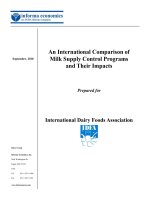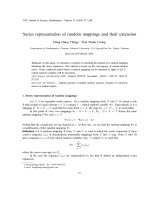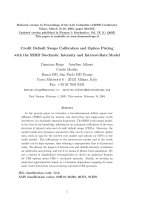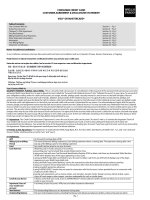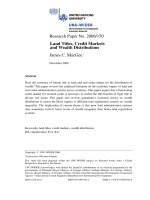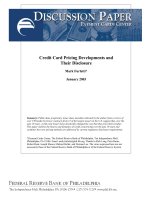Credit Card Pricing Developments and Their Disclosure pot
Bạn đang xem bản rút gọn của tài liệu. Xem và tải ngay bản đầy đủ của tài liệu tại đây (738.52 KB, 34 trang )
Credit Card Pricing Developments and
Their Disclosure
Mark Furletti*
January 2003
S
ummary: Public data, proprietary issuer data, and data collected by the author from a review of
over 150 lender-borrower contracts from 15 of the largest issuers in the U.S. suggest that, over the
p
ast 10 years, credit card issuers have drastically changed the way that they price their product.
This paper outlines the history and dynamics of credit card pricing over the past 10 years and
examines how new pricing methods are addressed by current regulatory disclosure requirements.
*Payment Cards Center, The Federal Reserve Bank of Philadelphia, Ten Independence Mall,
Philadelphia, PA 19106. Email: Thanks to Rick Lang, Peter Burns,
Robert Hunt, Joseph Mason, Michael Heller, and Norman Lee. The views expressed here are not
necessarily those of the Federal Reserve Bank of Philadelphia or of the Federal Reserve System.
Intense competition for new customers and the adoption of new technologies in the credit
card industry has decreased the price of credit for most consumers as measured by one well-
understood metric the nominal annual percentage rate (APR). For card issuers, this has meant
surrendering some of the net interest margin they enjoyed as a result of high APRs in the late
1980s and early 1990s and instituting pricing strategies that consider an individual borrower's risk
and behavior profile. As nominal APRs have decreased, issuers have come to rely on new pricing
techniques to maintain or increase portfolio profitability. These techniques include new APR
strategies, fee structures, and methodologies to compute finance charges.
This paper outlines the history and dynamics of credit card pricing over the past 10 years
and examines how pricing methods are disclosed to consumers. The analysis concludes by
discussing the challenges that newer, more complex pricing strategies pose to the current
disclosure framework established by the Truth in Lending Act.
Background
Industry Pricing Dynamics
Over the past 10 years, a series of innovations and market developments have
significantly changed the credit card industry. Advances in credit scoring, response modeling, and
solicitation technologies (e.g., e-mail, direct mail, telemarketing) have allowed experienced
issuers to more efficiently market their products and enabled new issuers to enter the card market
and grow quickly.
1
At the same time, it has become easier for consumers to find better credit card
alternatives and move their card balances from one issuer to another.
From 1991 to 2001, the number of mailed credit card solicitations increased fivefold to
5.01 billion (Figure 1). According to BAI Global, these solicitations in 2001 reached 79 percent
of U.S. households, which, on average, received five offers each month.
2
Issuers' aggressive mail
1
In the eight months since launching its Visa program at the end of 2001, Target Corporation issued 6
million credit cards and captured over $2 billion in outstandings. Similarly, other new entrants like Sears
and Juniper Bank have been able to grow very rapidly and compete against much larger issuers.
2
Compared with 73 percent of U.S. households receiving four offers in 2000.
1
marketing efforts have been augmented by telephone, event, and Internet campaigns such that
most consumers do not have to work very hard to find a new card. Product innovations, such as
transferring balances and eliminating annual fees, have also made it easier for customers to
switch cards. Customer loyalty, once ensured by an annual fee and a revolving balance built
through years or months of purchases, can now be easily captured by competitors with a no-fee,
low-rate offer to transfer balances.
As a result of these developments, issuers have struggled to maintain customer loyalty
through rewards programs, affinity/co-brand relationships, and enhanced customer service.
Despite these efforts, a card's nominal APR remains one of its most distinguishing characteristics.
The envelopes, letters, and applications that issuers use to solicit new business focus potential
customers' attention on either very low introductory APRs (e.g., 0.0 percent, 1.9 percent) or low
permanent APRs (e.g., 7.9 percent, 9.9 percent, 12.9 percent).
Low rates, however, are relatively new phenomena in the card industry. Researchers
studying the card industry in the 1980s and early 1990s found that credit cards had substantially
higher rates and returns than most other bank credit products (Ausubel, 1991). Further research
showed that credit card rates remained high when other interest rates fell, leading Calem and
Mester to conclude that card rates in that environment were "sticky" (Calem and Mester, 1995).
The data in Figure 2 illustrate this stickiness through 1992.
3
From 1992 to 2001, however, the average interest rate that issuers charged revolving
customers fell 320 basis points, from 17.4 percent to 14.2 percent. Issuer markup, a metric that
normalizes for funding costs by subtracting the six-month Treasury bill rate from the average
APR, decreased 330 basis points during the same period (Figure 3). Margins also narrowed
compared with those of other consumer loan products. The difference between the average
interest rate charged on a 24-month personal installment loan and a revolving credit card loan fell
2
from 3.8 percent in 1992 to 1.6 percent in 2001 (Figure 4). Taken together, it is clear that for
low-risk consumers who have revolving balances, credit card costs, as measured by APR, have
significantly declined over the past 10 years.
At the same time, more consumers gained access to credit cards, including those with
lower incomes. Between 1989 and 1998, the largest increases in bankcard ownership were
observed among consumers with the lowest levels of income (Durkin, 2000).
4
With generally
lower liquidity buffers and weaker credit histories, lower income consumers are typically
assessed higher annual percentage rates. An overall decrease in the average APR, coupled with an
increase in the number of lower income credit users, suggests that the average rate decrease for
many cardholders was even more pronounced than the average APR indicates.
Consumer awareness of annual percentage rate as a key cost measure, combined with the
ability to easily find new card offers and switch issuers, inevitably affected price competition and
rate stickiness. According to surveys conducted in 2000 by the Survey Research Center of the
University of Michigan, 91 percent of consumers who have a credit card are aware of the APR
they are charged on their outstanding balances, based on a "broad" definition of awareness
(Durkin, 2000).
5
Federal Reserve Board economist Thomas Durkin concludes that "it is clear that
awareness of rates charged on outstanding balances…has risen sharply since implementation of
the Truth in Lending Act" in 1968.
3
This paper is primarily focused on pricing changes that occurred in the mid- to late-1990s. For detailed
information about credit card pricing in the 1970s and 1980s, the reader may want to refer to Lewis
Mandell's The Credit Card Industry: A History (G. K. Hall & Co., 1990).
4
The following are the changes in the percentage of respondents to the survey cited by Durkin by income
quintile who indicated that they owned a bank-type credit card: lowest +65 percent; second lowest +61
percent; middle +16
percent; second highest +13 percent; highest +7 percent.
5
Awareness was measured using a narrow and a broad definition. Under the broad definition, only those
reporting that they did not know the rate were considered unaware. Under the narrow definition, those
reporting a rate less than 7.9 percent were also considered unaware. Using the narrow definition, awareness
in 2000 was measured at 85 percent. Previous measures of awareness from the Survey of Consumer
Finance did not distinguish between narrow and broad. These measures showed 27 percent in 1969, 63
percent in 1970, and 71 percent in 1977.
3
The Truth in Lending Act and Price Disclosure
The Truth in Lending Act (TILA) was enacted as Title I of the Consumer Credit
Protection Act in 1968. The act stated that "economic stabilization would be enhanced and that
competition would be strengthened by the informed use of credit resulting from an awareness of
credit costs on the part of consumers." TILA charged the Federal Reserve with creating and
enforcing the specific rules needed to implement the legislation. These rules are embodied in the
Board of Governors’ Regulation Z (Truth in Lending).
Truth in Lending, as it applies to credit card accounts, is primarily disclosure focused.
The act is silent about the number, amount, variety, or frequency of fees and credit-related
charges that issuers can impose. It does not suggest ceilings, price controls, or limits for any
charges. Instead, it requires that issuers inform potential customers about specific pricing terms at
specific times. Regulation Z specifies that select terms be disclosed at specific points, including
the following: upon solicitation or application; before first use of the card; and upon receiving a
statement.
6
The level of detail for disclosure at each point varies (Table 1).
When first promulgated, Truth in Lending rules required that issuers of credit cards
disclose information about the computation of APRs and finance charges to customers "before the
first transaction [was] made" on the account. To meet this requirement, issuers mailed consumers
a "single written statement" that explained the costs of the card after his or her account was
opened.
Since 1968 both Congress and the Board of Governors ("the Board") have mandated
changes to Truth in Lending disclosure requirements. One of the most well-known features of
Truth in Lending, a pricing disclosure box, resulted from the amendment of TILA by the Fair
Credit and Charge Card Disclosure Act of 1988. Informally referred to as the "Schumer box"
after the congressman from New York who was instrumental in the legislation's passage, the box
4
displays APR and fee information on card applications and solicitations in a table designed to be
easy for consumers to read and use for comparison purposes. By requiring that issuers display this
box on applications and solicitations, the act enabled consumers to compare offers and rates
before opening an account. An example of the "Schumer box" is shown in Table 2.
Similarly, in response to the potentially confusing number of different APRs that can now
be associated with a single credit card account (e.g., balance transfer APRs, cash advance APRs,
purchase APRs), the Board further modified Regulation Z in 2000. As a result of this
modification, issuers are required to disclose the APR for purchases in at least 18-point type on
applications and solicitations. The modification also requires them to disclose balance-transfer
fees that apply to an account.
The Board, through modifications to Regulation Z, and Congress, through legislation,
have updated Truth in Lending to take into account product evolution. Recent changes in how
issuers price credit cards, however, have resulted in new levels of pricing complexity and created
a structure of credit costs that can impact some customers very differently than others. That is, the
cost that a consumer faces greatly depends on the way he or she uses the credit card.
This paper will explore the evolution of credit card pricing and examine the disclosure
requirements of Truth in Lending (Regulation Z) that relate to these pricing changes. Analysis
will rely on public data, proprietary issuer data, and data collected by the author from a review of
over 150 lender-borrower contracts from 15 of the largest issuers in the U.S. over a five-year
period.
7
Pricing and fee changes are organized into three categories nominal APR changes, fee
structure changes, and computational technique changes and presented in order of most to
6
Regulation Z also requires that specific information be disclosed in advertisements for credit (e.g., ads on
television or in magazines) and when certain credit terms are changed. This paper does not examine these
regulatory disclosure requirements.
7
Lender-borrower contracts are the documents issuers send their customers that often include fee
disclosures, account usage terms and conditions, borrower and lender responsibilities, etc. Issuers typically
refer to them as Cardmember Agreements or Required Disclosures, and modify them with Change in Term
Notices. These documents are usually made available to cardholders before the first transaction is made on
the account.
5
least consistent with the current format of regulatory disclosure requirements. Examples of each
type of change are provided, along with an analysis of each change's impact on issuers' revenues.
Nominal APR Changes
Until the early 1990s, credit card pricing, as it related to nominal APRs, might best be
characterized in two ways: high and simple. Card issuers generally had one or two card products
(e.g., a classic card and/or a gold card) that each had a single annual percentage rate of around 18
percent. If an applicant for credit could pass the risk threshold set by the issuer, he or she would
receive a card. If the applicant's credit behavior was determined to be too risky, his or her
application was denied. This resulted in a portfolio of customers who were priced as if they had
very similar probabilities of default.
Evidence of these risk-indifferent APR strategies can be observed in public "rate decrease
announcements" that issuers released to the media in the early 1990s.
8
At the time, issuers
generally had one rate that they extended to all customers. When they lowered this rate, they did
so for almost all of their accounts. A 1993 issue of CardTrack, a publication of CardWeb.com,
reported that Citibank was offering a 15.4 percent rate to all new applicants. This was the same
rate it was offering to virtually all of its current customers. CardTrack also reported that 90
percent of Citibank cardholders had been paying an APR of 19.7 percent a few years earlier.
Other large issuers, such as Chase, Chemical, AT&T, and Bank One, made rate-cut
announcements that were similarly applied to all current and new customers (Stango, 2002).
Competitive pressures and increasing price awareness among consumers, however, eventually
made these undifferentiated pricing strategies obsolete.
Risk-Based Solicitation APRs
Issuers have generally used risk-based pricing techniques in two ways. The first is in
setting the interest rate initially offered to a consumer. Using credit bureau attributes, issuers
6
assess the default risk of a consumer and essentially charge him or her a premium for that risk.
This premium is typically reflected in the APR stated in the card application or solicitation.
Prior to the early 1990s, by charging every customer the same rate, issuers made much
higher profits from customers with very low default risk.
9
These excess profits could be used to
cover defaults generated by customers whose risk, over time, had increased. As issuers began
competing on APR, however, they were forced to eliminate this cross-subsidization and assess
APRs based on an analysis of individual borrower risk.
Ultimately, a card's nominal APR became a competitive focal point and drove
widespread adoption of risk-based pricing. Issuers who failed to adjust pricing appropriately by
risk segments would expose themselves to serious adverse selection problems. Issuers today may
have hundreds of different APR price points. With few exceptions, these points are highly
correlated to some risk measure.
10
Figure 5 illustrates how lower-risk borrowers have benefited
from risk-based pricing. This figure uses account pricing and yield data gathered from a group of
top prime issuers by Argus Information & Advisory Services, a financial services consulting firm
based in White Plains, New York. The graph shows the difference between the effective finance
charge yield for the highest risk revolving customers (FICO scores less than 600) and customers
in other risk cohorts (data from 1992 are estimated from rate announcements). The 1998, 2000,
and 2002 Argus data illustrate that the discount that lower risk customers receive on their APR
has increased significantly since the early days of risk-indifferent pricing. The lowest risk
customers, who once paid the same price as high-risk customers, now enjoy rate discounts that
8
Stango (2002) observes that comments about high card rates from President George H. Bush in 1991 and
the Senate's passage of a bill in that same year capping APRs influenced many large issuers to lower rates.
(The Senate's bill was never signed into law.)
9
The risk-based pricing techniques referred to in this section impact customers only to the extent to which
they carry a balance on their credit card. For customers who always pay their balance in full, such pricing
techniques are effectively inconsequential.
10
One notable exception to the risk-based pricing strategy is the co-branded airline portfolio. Co-branded
air cards that reward users with frequent-flyer miles typically attract low-risk business travelers despite
having a high rate (e.g., 18.9 percent) and an annual fee.
7
can reach more than 800 basis points.
11
At the other end of the risk spectrum, these strategies
have enabled issuers to grant more people (e.g., immigrants, lower income consumers, those
without any credit experience) access to credit, albeit at higher prices. Former Federal Reserve
Governor Lawrence Lindsey has referred to this phenomenon as "the democratization of credit"
(Black and Morgan, 1998). Examining data from the Survey of Consumer Finance, Stavins also
noted the same risk-based pricing trend. She observes that "consumers with higher ratios of
unpaid credit card debt to income, and thus [who were] worse credit risks for the issuers, were
charged higher interest rates" (Stavins, 2000).
Risk-Based Penalty APRs
Risk-based pricing strategies can also be used to modify a customer's APR after he or she
has started using the account. Issuers have recently implemented "penalty APR" strategies that
allow them to adjust upward the nominal APR of customers whose risk, perhaps because of
recent late payments or increasing levels of debt, is no longer in line with their original APR.
12
In
the author's study of lender-borrower contracts, the introduction of penalty pricing strategies was
observed in the late 1990s.
13
An example of language that explained these policies in 1997 read
as follows: "Your APRs may increase if you fail to make a payment to us when due, you exceed
your credit line, or you make a payment to us that is not honored by your bank." The same study
revealed that issuers had taken these policies a step further in recent years. Agreements were
changed to allow issuers to incorporate into the penalty pricing decision information they
11
One could argue that the customers at any given FICO score might be riskier today than in 1998 (i.e., a
650 FICO score in 2002 carries a higher risk of default than a 650 did in 1998) because of changes in
issuers' underwriting standards or a less favorable economic environment. There are three reasons to doubt
the material impact of such factors. First, in an attempt to control for the impact of economic cycles, the
data are presented relative to the yield of highest risk customers (FICO scores < 600). Second, credit
modeling experts believe that Fair Isaac frequently recalibrates its FICO model in order to ensure that its
score-odds ratio is relatively stable. This mitigates the effects that different economic environments might
have on the score. Finally, the underwriting standards of the prime/super-prime issuers in the Argus study
are thought to have been stable throughout the period with little or no sub-prime origination.
12
Penalty pricing tactics employed by Direct Merchants (Metris) led CardTrack to observe that "credit card
interest rates have passed the 30% barrier!" As reported in May 2000, a 31.99 percent APR was imposed on
Metris customers who were late three times during the year or who fell 60 days delinquent.
8
obtained from credit bureaus about other loan behavior. Newer policies read as follows: "We may
increase the annual percentage rate on all balances to a default rate of up to 24.99 percent…if you
fail to make a payment to us or any other creditor when due, you exceed your credit line, or you
make a payment to us that is not honored by your bank" [emphasis added].
14
Nominal APR Changes and Regulatory Disclosure Requirements
The risk-based pricing strategies described above are exclusively focused on the nominal
APR component of credit card pricing. Disclosures required by Regulation Z inform customers
about such APRs upon solicitation in two sections of the "Schumer box" (i.e., Annual Percentage
Rate (APR) for Purchases; and Other APRs) and on periodic statements (i.e., Annual Percentage
Rate). In addition, Regulation Z requires that the nonintroductory purchase APR be displayed in
18-point type in the "Schumer box" on new card offers.
Overall, Truth in Lending disclosure requirements ensure prominent display of each APR
associated with an account. The nominal APR-focus of Truth in Lending statements and of
issuers' marketing materials has no doubt contributed to consumer awareness of APRs as key
determinants of credit cost.
Fee Structure Changes
Another way that credit card pricing has developed is in the "unbundling" of costs in the
form of fees. As previously mentioned, card pricing in the 1980s and early 1990s was relatively
simple. Issuers typically charged a relatively high interest rate and an annual fee of around $25
that covered most of the expenses associated with card usage. Few issuers charged over-limit fees
or late fees, and when they did, these fees were relatively small.
15
The increased competition for
new accounts that developed in the mid-1990s, however, changed all of this. Rates came down, as
13
The author would like to thank MarketIQ, a direct marketing competitive intelligence firm in Fair Haven,
New Jersey, for contributing to the author's study.
14
Some issuers' policies explained that a consumer could get his or her pre-penalty rate back after making
12 consecutive on-time payments.
15
Typical late fees ranged from $5 to $10. The average late fee charged in 1990, according to CardWeb,
was $9.
9
described in the previous section, and issuers eliminated the once universal annual fee. Today,
these fees are almost nonexistent in prime portfolios not associated with a rewards program. The
data that Argus Information & Advisory Services collected from top issuers show that just 14
percent of customers who are not enrolled in a rewards program (e.g., a frequent-flyer-miles
program) paid an annual fee in 1998 and just 2 percent did in 2002.
16
With average interest rates on the decline and annual fees becoming unpopular among
their customers, issuers developed more targeted fee structures to replace lost revenues. In lieu of
charging all of their customers an annual fee that subsidized the costs associated with the
behaviors of a few, they began to assess fees directly on those customers whose card usage
behaviors drove costs higher. As issuers started unbundling costs and creating behavior-based
fees, fees rebounded and have again become an important component of issuer revenues (Figure
6). Ultimately, two distinct families of fees have emerged: risk-related fees and
convenience/service fees.
Risk-Related Fees
In addition to using different APRs to better price for risk, issuers have significantly
increased the use of risk-related fees. These include late fees, over-limit fees, and bounced-check
fees. The industry's modeling and analysis efforts have shown that customers who are late or over
their credit limit or who write bad checks are more likely to default. Risk-related fees help
compensate issuers for this increased risk.
17
For lower risk customers, risk-related fees can deter
sloppy payment behavior and poor credit-line management.
The examination of lender-borrower contracts from 1997 through 2002 revealed that
issuers significantly increased traditional risk-based fee levels and created new fees. For example,
in 1997, the risk-based fee that most issuers charged customers who had exceeded their credit line
16
The data from Argus also show that the average annual fee charged on a nonrewards card has fallen from
$3.31 in 1998 to $0.50 in 2002.
17
Issuers may also be aware that customers who are consistently paying these fees are likely to have fewer
and less attractive credit alternatives.
10
was less than $20. By 2002, most top issuers had adopted an over-limit fee structure that was
tiered by balance size and nearly doubled the fee for over-limit customers. These issuers now
assess a $35 fee to those customers who exceed their credit line and have a balance of over
$1000. Similar increases were observed for late fees and returned-check (NSF) fees.
18
Evidence
of the impact of these increases on the average late fee can be seen in Figure 7.
Issuers were also observed introducing new risk-based fees during this period. For
example, in the late 1990s, issuers began assessing a returned-check fee for credit card
convenience checks. Such checks allow customers to access their credit card's line of credit using
a paper check. If a customer writes a convenience check for an amount that exceeds his or her
available credit line and the issuer chooses not to honor the check, most issuers now assess that
customer a fee that ranges from $29 to $35.
The impact of higher risk-based fees on issuers' revenues has been substantial. In May
2002, Cardweb.com estimated that half of all consumers in the U.S. who had a credit card had
been late at least once in the previous 12 months. Issuers’ annual late fee revenues more than
quadrupled from 1996 to 2001 ($1.7 to $7.3 billion) while average late fees only doubled ($13 to
$27). This indicates that, in addition to an increase in the amount of the average late fee, there has
been a substantial increase in late fee incidence. Cardweb.com also noted that late-fee revenue
currently represents the third largest revenue stream for issuers after interest and interchange
revenue.
19
Argus Information & Advisory Services data compiled from top prime issuers during
the first quarter of 2002 showed that 5 percent of issuers' active cardholders were assessed an
over-credit-limit fee during the three-month period. Information on the size and growth of other
risk-based fee types is not available. The examples above, however, strongly suggest that risk-
18
NSF is a return check reason code that stands for "not sufficient funds."
19
Interchange revenue is derived from a fee set by the card associations that issuers assess merchants each
time a credit card purchase is made. Depending on the card association, the fee can range from 1.5 to 4.0
percent of the value of the transaction.
11
based fees have become an important source of revenue for card issuers and have replaced a
significant portion of the revenues lost from the elimination of annual fees and lowered APRs.
Convenience and Service Fees
Issuers have also unbundled servicing costs, introducing fees for services and
conveniences that were once paid for by all customers out of annual fee and interest revenues.
Some of these new fees, like those levied on the credit card purchase of casino chips or on cash
advances, compensate issuers for the fraud risk thought to be inherent in cash or cash-equivalent
transactions. Other fees, like those imposed for stop payment requests, statement copies, or
replacement cards, more directly compensate issuers for out-of-pocket expenses (e.g., customer
service representative time, telecommunications expense). In addition to defraying operational
costs, these new fees are generally priced to provide attractive profit margins.
Table 3 lists 11 changes to convenience and service fees observed in the author's lender-
borrower contract research. Three of these are described in more detail below.
Starting in the late 1990s, a number of issuers began assessing a foreign currency
conversion fee of 2 percent on purchases that cardholders make outside the U.S. This fee was
added on top of a 1 percent fee already assessed by MasterCard and Visa. The 1 percent fee
charged by the associations covers the transaction costs associated with the actual exchange.
Some industry sources suggest that the 2 percent fee levied by issuers is related to the long-
distance telecommunications charges associated with customer service calls that originate in
foreign countries from traveling customers.
More recently, several issuers have added a phone payment convenience fee. This fee,
which ranges between $10 and $25, is assessed when customers choose to pay over the phone
instead of through the mail.
20
While this fee may seem like an expensive alternative when
20
When an issuer accepts a payment over the phone, it receives authorization from its customer to debit the
customer's checking account for the payment amount.
12
compared to the cost of postage, customers who typically rely on phone payments are often close
to missing their payment due date and being assessed a $35 late fee.
Finally, most issuers have adopted balance transfer fees. These fees, typically around 3
percent of the amount transferred with various minimums and maximums, are often assessed on
balances transferred from a competitor's card. These balances often qualify for a discounted
promotional APR. The balance transfer fee helps offset costs associated with customer service
representatives who initiate the balance transfers and may help reduce "rate surfing" (i.e., the act
of continually moving balances among cards to take advantage of short-term promotional rates).
21
Information on the revenue impact of convenience and service fees is limited. Argus
Information and Advisory Services data indicate that the top prime issuers are earning about $8
per active account per year in cash advance fees and $6 per active account per year in other fees
(excluding risk-related fees). The actual impact that fees have on revenue per account can be
observed only among the few issuers who separately list nonsecuritization fee income in their
annual reports. One such annual report revealed a doubling of fee revenue per account from $4 in
1998 to $8 in 2001.
Fee Changes and Regulatory Disclosure Requirements
Regulation Z requires that issuers, upon application or solicitation, inform customers
about the annual fee, minimum finance charge, cash advance fee, balance transfer fee, late fee,
and over-limit fee associated with an account. Before the first transaction is made on the account,
issuers must disclose "other charges," that is "any charge other than a finance charge that may be
imposed as part of the plan, or an explanation of how the charge is determined." The official staff
commentary on Regulation Z, which represents the Board staff's interpretations of the regulation,
further provides that only "significant charges" must be disclosed as "other charges." The
21
If these fees become universally adopted, they will make it more expensive for consumers to switch
cards.
13
commentary offers late fees, annual fees, over-limit fees, and account closure fees as examples of
"significant charges."
Regulation Z does not explicitly address disclosure of the foreign currency conversion
fee. Unlike most fees that can be observed upon a detailed review of a card statement, foreign
currency conversion fees are often rolled into the transaction amount or the conversion factor.
22
Other fees that are not specifically mentioned in the regulation include phone payment fees, wire
transfer fees, and stop payment fees on credit card convenience checks.
23
Issuers generally
disclose these fees to consumers by including a menu or a description of these other fees in
"welcome kit" mailings to new customers or in "Cardmember Agreements." The organization,
detail, and prominence of these menus or descriptions vary by issuer.
Computational Technique Changes
In addition to adopting risk-based pricing and expanding fees, issuers are employing new
computational practices that increase effective yields without affecting the disclosed nominal
APRs. The author's lender-borrower contract research uncovered six examples among the major
issuers. Three of the more common practices are detailed below; explanations of the remaining
three can be found in Table 4.
Payment Allocation
Many issuers have added sections to their contracts to explain how they allocate
payments to revolving balances. As mentioned previously, the number of APRs that can be
applied to the balances on an account has increased dramatically over the past 10 years (e.g.,
purchase APR, promotional APR, cash APR, balance transfer APR). Issuers have created various
average daily balance categories to which these different rates are applied. One issuer's disclosure
statement explained the way in which payments would be applied to different balance categories
22
In a New York Times article, "Credit Card Swipe: Concealed Charges," reporter Susan Stellin noted that
just three major issuers separate out their foreign currency exchange charges on customers' statements.
14
as follows: "We will allocate your payment and any credits to pay off balances at low periodic
rates before paying off balances at higher periodic rates." This computational methodology
effectively "protects" revolving balances at higher rates. For example, issuers can offer a
customer with a $2500 revolving balance at 18.9 percent an opportunity to transfer another $2500
balance onto the card at an APR of 2.9 percent. Since the customer's payments are allocated to the
2.9 percent balance first, the issuer effectively "protects" or locks in the $2500 balance at 18.9
percent until the lower rate balance is repaid.
Compounded Interest
By 1997, most issuers had switched from monthly to daily compounding of interest by
changing the computational method for calculating average daily balances. Before the adoption of
daily compounding, disclosures typically explained that "on each day of the billing period we
subtract payments, add new purchases and fees, and make adjustments" to calculate the average
daily balance. By the end of the 1990s, however, the language had changed as follows: "To get
the daily balance we take the beginning balance for every day, add any new transactions, fees,
and any finance charge on the previous day's balance, subtract any credits or payments, and
make other adjustments [emphasis added]." By adding finance charges to the balance each day,
issuers increased finance charge revenue without increasing stated annual percentage rates.
24
This
has the effect of increasing the effective finance charge yield of a portfolio by as much as 10 to
20 basis points. For instance, the annual effective portfolio yield on a loan with an APR of 18.99
percent compounded 12 times a year is 20.73 percent. If the same loan is compounded 365 times
per year, its effective yield increases 18 basis points to 20.91 percent.
23
On November 26, 2002, the Board proposed credit card-specific revisions to Regulation Z's official staff
commentary. One of these revisions would add phone payment fees to the list of "other charges" that must
be disclosed before the first transaction occurs on an account.
24
The annual percentage rate (APR) disclosed on a customer's statement is calculated by dividing finance
charges for the period by the average daily balance for the period. While increasing the frequency of
compounding increases the finance charge (i.e., the numerator), adding finance charges to the average daily
balance (i.e., the denominator) each day offsets the effect of compounding on the disclosed APR.
15
Double-Cycle Interest
Another pricing innovation involves a change in the treatment of the grace period during
which interest does not accrue. One of the unique advantages of credit card borrowing has been
the interest-free period consumers who pay their bill in full receive from the time they make a
purchase until the date their payment is due. This period can vary from 40 to 60 days. The lender-
borrower contract study revealed that a number of issuers have effectively eliminated the grace
period for consumers who, after making a full payment or not having had a balance in the
previous month, do not make a full payment in the next month.
For example, consider a customer without a previous balance who has a 10 percent APR
on purchases and who makes a purchase of $1000 on May 1 (the first day of the customer's May
cycle). The customer then receives a bill for $1000 on June 1. Instead of paying the entire
balance, the customer sends the issuer a minimum payment of $20, which arrives on June 30.
When the customer's account cycles on the night of June 30, the issuer will assess finance charges
for the month of June and reach back and add finance charges for the entire month of May. In this
example, instead of billing approximately $8 in finance charges (based on the APR of 10
percent), the issuer will bill approximately $16. It should be noted that double-cycle interest is
assessed only in the month in which a customer moves from a nonrevolving to a revolving state.
The interest computation returns to a single-cycle method for the remaining months in the
revolving period.
Data on the revenue impact of the changes described above and in Table 4 are limited.
Given that approximately three-fifths of all cardholders pay interest on their balance and that half
of those who pay interest make only the minimum payment (CardWeb, March 7, 2002), it seems
likely that these changes have had at least a material effect on issuers' revenues and have
contributed to the shift in industry revenue profiles.
16
Computational Technique Changes and Disclosure Requirements
Double-cycle billing is explicitly addressed by Regulation Z in a section of the "Schumer
box" entitled "Method of Computing the Balance for Purchases." Here issuers are required to
indicate the balance-computation technique they use with one of the following descriptors:
average daily balance (including new purchases), average daily balance (excluding new
purchases), two-cycle average daily balance (including new purchases), two-cycle average daily
balance (excluding new purchases), adjusted balance, or previous balance. Additional
explanations or definitions are not required by the regulation upon solicitation or application.
Issuers are not required to provide detailed explanations of balance-computation techniques until
after the account is opened. This means that consumers wanting to find out what the term "two-
cycle average daily balance" signifies before filling out an application for a card would have to
conduct their own research. As a practical matter, this may be easier for consumers with access to
the Internet than for others.
25
Detailed descriptions of the practices referred to above and in Table 4 are usually not
featured in application or solicitation materials.
26
Issuers disclose the details of these
computational techniques in various ways in their lender-borrower contracts and factor their
effects into TILA-required periodic statement disclosures. For example, consumers who revolve a
balance might become aware of the impact of daily compounded interest if, upon receiving their
statement, they carefully review the issuer's calculation of the total finance charges disclosed on
their statement. Similarly, customers who pay finance charges on their late fees, on their balance
between the statement date and payment date, or from their transaction date to their posting date
might notice, upon an exceptionally careful review, increased finance charge amounts on their
statement.
25
A search on "two-cycle average daily balance" on Google.com returns 10 nongovernmental, consumer-
oriented web sites (such as practicalmoneyskills.com, credit-cards.com, bankrate.com) that explain how
two-cycle interest can influence the cost of credit.
17
Conclusion
Substantial changes in the dynamics of credit card pricing have occurred over the past
decade. The relatively straightforward pricing model of a single APR, an annual fee, and modest
penalty fees has been replaced by a model with a complex set of APRs, new and increased fee
structures, and sophisticated finance charge computation techniques. This "unbundled" pricing
structure has created a card product for which consumers pay substantially different prices based
on individual behavior. During this time, however, the overall disclosure framework mandated by
the Truth in Lending Act has changed very little.
27
The adoption of new pricing structures has increased credit costs for some consumers and
decreased it for others. Low-risk borrowers, who behave in such a way as to avoid new and
increased fees, generally experience lower credit costs than they might have several years ago.
Higher risk borrowers, who may not have previously qualified for unsecured credit, can now
obtain credit cards by paying a risk premium. Other borrowers, because of their consumption of
fee-based services or perceived level of risk, now face higher credit costs. To a large extent the
new pricing structure results in more credit card users "paying their own way."
A pricing structure that better allocates issuer's risk and servicing expenses has likely
come at a cost in the form of a complex and customized product whose pricing is difficult to
summarize. In today's environment of highly individualized pricing, it is difficult to imagine a
generic disclosure requirement that could meet the burden of clearly explaining the total costs of
credit that any given consumer would face. In 1996, in a report to Congress on TILA, the Board
of Governors foresaw this possibility when it reported the following: "The ability to ensure
accurate disclosure of the "true" costs gets more difficult as creditors increase the number of
26
The balance computation technique is disclosed with a brief descriptor in the "Schumer box," but this
descriptor doesn't give consumers the details necessary to understand how the interest is actually computed.
27
As previously mentioned, the last major modification occurred with the passage of the Fair Credit and
Charge Card Disclosure Act (FCCDA) 14 years ago. The FCCDA amended TILA and introduced the
conspicuously placed "Schumer box." Since that time, the Board of Governors has modified TILA's
underlying regulation and regulation staff commentary to respond to some of these pricing changes (e.g.,
18
credit products, pricing alternatives, and optional services. The permutations of possible costs to
be disclosed and the potential for error also increase."
28
While some of the pricing innovations described in this paper might easily fit into the
existing regulatory disclosure format, it is clear that others pose significant disclosure challenges.
Is there a simple way to communicate two-cycle billing such that consumers understand that their
credit costs will be higher if they occasionally revolve balances? Can payment allocation
methods be explained in a way such that customers with low-rate promotional balances
understand the cost implications of making higher-rate purchases? Is there a simple way to
explain that when consumers miss a payment with one issuer, it can affect the price they pay for
credit to another?
Recent survey results indicate that consumers have mixed feelings about Truth in
Lending statements. In his paper entitled "Consumers and Credit Disclosures: Credit Cards and
Credit Insurance," economist Thomas Durkin (2002) points out that, in consumer surveys
conducted for the Board of Governors in 1994, 1997, and 2001, over three-quarters of
respondents agreed that Truth in Lending statements are complicated.
29
Forty percent of those
surveyed did not find the statements helpful as they relate to bank-type credit cards, and 77
percent said that the statements did not affect their decision to use credit cards in any way.
Although consumers may find these disclosures complex and not always helpful, Durkin
concludes that consumers "appear to like knowing that the behavior of creditors is being
monitored."
Based on this survey data, it is not clear that requiring more details in regulatory
disclosures would be useful for consumers. An alternative is to promote understanding of credit
requiring larger point type, penalty rate disclosures, and cash advance and balance transfer APR
disclosures).
28
From the Board of Governors' Report to Congress, Finance Charges for Consumer Credit under the
Truth in Lending Act, April 1996, p. 8.
29
This includes Truth in Lending statements required for credit cards, home equity loans, and installment
loans.
19
costs through education. Educated consumers can change the terms on which issuers compete and
force transparency in price structures. In either case, understanding new developments in credit
card pricing is important for ensuring that information is available for consumers to make an
informed decision about credit.
20
Sources
Argus Information & Advisory Services, White Plains, NY, Issuer Pricing Data, July 2002.
Ausubel, Lawrence M. "The Failure of Competition in the Credit Card Market," American
Economic Review, March 1991, pp. 50-81.
BAI Global, "All Time Record High Credit Card Mail Volume Set in 2001," press release,
<>, April 2002.
Black, Sandra E., and Donald P. Morgan. "Risk and the Democritization of Credit Cards,"
Federal Reserve Bank of New York, Research Paper 9815, 1998.
Board of Governors of the Federal Reserve System. The Profitability of Credit Card Operations
of Depository Institutions, Annual Report to Congress, June 2002.
Board of Governors of the Federal Reserve System. Federal Reserve Bulletin. February 1969, pp.
126-149.
Board of Governors of the Federal Reserve System, Federal Reserve Statistical Release G.19-
Consumer Credit, 1972-2002.
Board of Governors of the Federal Reserve System. Finance Charges for Consumer Credit Under
the Truth in Lending Act, Report to Congress, April 1996.
Board of Governors of the Federal Reserve System. Regulation Z.
Board of Governors of the Federal Reserve System. Official Staff Commentary on Regulation Z.
Business Week Online. "Target Takes a Gamble That Markets Don't Like,"
< April 1, 2002.
Calem, Paul S., and Loretta J. Mester. "Consumer Behavior and the Stickiness of Credit-Card
Interest Rates," American Economic Review, December 1995, pp. 1327-36.
Cardweb.com, CardTrack. "31.99% APR," < May 2000.
Cardweb.com, CardTrack. "Big Guy Fight," < July 2000.
Cardweb.com, CardTrack. "Card Leaders," < May 24,
2002.
Cardweb.com, CardTrack. "Fee Frenzy," < March 21, 2002.
Cardweb.com, CardTrack. "Late Fee Bug," < May 17,
2002.
Cardweb.com, CardTrack. "Minimum Payments," < March
7, 2002.
21
Cardweb.com, CardTrack. "National Credit Education Week," <
cardtrack/> April 1993.
Cardweb.com, CardTrack. "Profit Squeeze," < October
1999.
Durkin, Thomas A. "Credit Cards: Use and Consumer Attitudes, 1970-2000," Federal Reserve
Bulletin, September 2000, pp. 623-34.
Durkin, Thomas A. "Consumers and Credit Disclosures: Credit Cards and Credit Insurance,"
Federal Reserve Bulletin, April 2002, pp. 201-13.
Federal Deposit Insurance Corporation, commercial bank profitability press releases, 1994-2001.
Juniper Bank. "Juniper Bank Passes $100 Million Milestone," press release, December 18, 2000.
MarketIQ, Fair Haven, NJ, Lender-Borrower Contracts, July 2002.
Stango, Victor. "Strategic Responses to Regulatory Threat in the Credit Card Market," Federal
Reserve Bank of Chicago Working Paper 2002-02, February 2002.
Stavins, Joanna. "Credit Card Borrowing, Delinquency, and Personal Bankruptcy," New England
Economic Review, July/August 2000, pp.15-30.
Stellin, Susan. "Credit Card Swipe: Concealed Charges," New York Times, July 12, 2002.
U.S. House of Representatives, House Report No. 90-1040 on Consumer Credit Protection Act,
December 13, 1967.
22
Table 1
Key Disclosure Provisions of Regulation Z
Timing Terms Disclosed
Upon Application or Solicitation
• Annual percentage rate (including penalty rates) for
purchases, cash advances, and balance transfers
• Fees for issuance or availability (e.g., annual fees)
• Minimum finance charge
• Grace period
• Balance computation method
• Statement on charge card payments
• Cash advance fee
• Late payment fee
• Over-the-limit fee
• Balance transfer fee
Before First Use
• Grace period
• Periodic rates used to calculate finance charges and
corresponding annual percentage rates
• Balance computation method
• The amount of any significant charge, other than a finance
charge, that may be imposed as part of the plan, or an
explanation of how the charge will be determined (e.g., late
fees, over limit fees, statement copy fees, annual fees,
account closure fees)
• Any applicable security interest
• Consumers' billing rights
On Periodic Statements
• Previous balance
• Identification of transactions
• Credits
• Periodic rate and corresponding annual percentage rate
• Balance on which finance charge is computed
• Amount of finance charge
• Other charges
• Closing date of billing cycle
• Free-ride period
• Address for notice of billing errors
Source: Regulation Z
23
24
Table 2
An Example of a Typical "Schumer box" Disclosure
Source: Regulation Z, Appendix G
